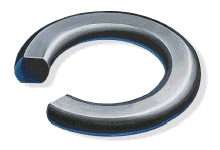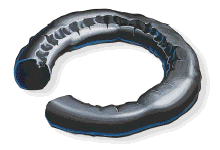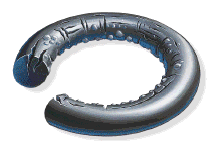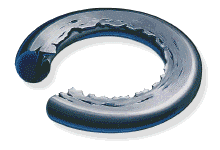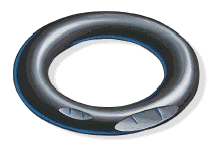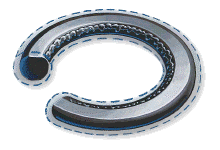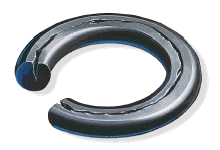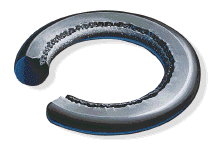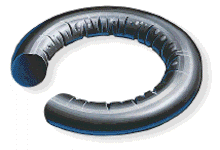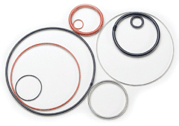 |
 |
|
O-Ring Failure Analysis |
|
ABRASHION
|
|
| Description: The seal or parts of the seal exhibit a flat surface parallel to the direction or motion. Loose particles and scrapes may be found on the seal surface. Contribution Factors: Rough sealing surfaces. Excessive temperature. Process environment containing abrasive particles. Dynamic motion. Poor elastomer surface finish. Suggested Solutions: Use recommended gland surface finishes. Consider internally lubed elastomers. Eliminate abrasive components. |
|
|
COMPRESSION
|
|
| Description: The seal exhibits a flat-sided cross-section, the flat sides correspoding to the mating seal surfaces. Contribution Factors: Excessive compression. Excessive temperature. Incompletely cured elastomer. Elastomer with high compression set. Excessive volume swell in chemical. Suggested Solutions: Low compression set elastomer. Proper gland design for the specific elastomer. Confirm material compatibility. |
|
|
CHEMICAL DEGRADATION
|
|
| Description: The seal may exhibit many signs of degradation including blisters, cracks, voids or discoloration. In some cases, the degradation is observable only by measurement of physical properties. Contribution Factors: Incompatibility with the chemical and/or thermal environment. Suggested Solutions: Selection of more chemically resistant elastomer. |
|
|
EXPLOSIVE DECOMPRESSION
|
|
| Description: The seal exhibits blisters, pits or pocks on its surface. Absorption of gas at high pressure and the subsequent rapid decrease in pressure. The absorbed gas blisters and ruptures the elastomer surface as the pressure is rapidly removed. Contribution Factors: Rapid pressure changes. Low-modulus/hardness elastomer. Suggested Solutions: Higher-modulus/hardness elastomer. Slower decompression (release of pressure). |
|
|
EXTRUDION
|
|
| Description: The seal develops ragged edges (generally on the low-pressure side) which appear tattered. Contribution Factors: Excessive clearances. Excessive pressure. Low-modulus/hardness elastomer. Excessive gland fill. Irregular clearance gaps. Sharp gland edges. Improper sizing. Suggested Solutions: Decrease clearances. Higher-modulus/hard-ness elastomer. Proper gland design. Use of polymer backup rings. |
|
|
INSTALLATION DAMAGE
|
|
| Description: The seal or parts of the seal may exhibit small cuts, nicks or gashes. Contribution Factors: Sharp edges on glands or components. Improper sizing of elastomer. Low-modulus/hardness elastomer. Elastomer surface contamination. Suggested Solutions: Remove all sharp edges. Proper gland design. Proper elastomer sizing. Higher-modulus/hardness elastomer. |
|
|
OOUTGASING
|
|
| Description: This failure is often very difficult to detect from examination of the seal. The seal may exhibit a decrease in cross-sectional size. Contribution Factors: Improper or improperly cured elastomer. High vacuum levels. Low hardness/plasticized elastomer. Suggested Solutions: Avoid plasticized elastomers. Ensure all seals are properly post-cured to minimize outgasing. |
|
|
OVERCOMPRESSION
|
|
| Description: The seal exhibits parallel flat surfaces (corresponding to the contact areas) and may develop circumferential splits within the flattened surfaces. Contribution Factors: Improper design—failure to account for thermal or chemical volume changes, or excessive compression. Suggested Solutions: Gland design should take into account material responses to chemical and thermal environments. |
|
|
PLASMA DEGRADATION
|
|
| Description: The seal often exhibits discoloration, as well as powdered residue on the surface and possible erosion of elastomer in the exposed areas. Contribution Factors: Chemical reactivity of the plasma. Ion bombardment (sputtering). Electron bombardment (heating). Improper gland design. Incompatible seal material. Suggested Solutions: Plasma-compatible elastomer and compound. Minimize exposed area. Examine gland design. |
|
|
SPIRAL FAILAUARE
|
|
| Description: The seal exhibits cuts or marks which spiral around its circumference. Contribution Factors: Difficult or tight installation (static). Slow reciprocating speed. Low-modulus/hardness elastomer. Irregular O-ring surface finish (including excessive parting line). Excessive gland width. Irregular or rough gland surface finish. Inadequate lubrication. Suggested Solutions: Correct installation procedures. Higher-modulus elastomer. Internally-lubed elastomers. Proper gland design. Gland surface finish of 8–16 microinch RMS. Possible use of polymer backup rings. |
|
|
THERMAL DEGRADATION
|
|
| Description: The seal may exhibit radial cracks located on the highest temperature surfaces. In addition, certain elastomers may exhibit signs of softening—a shiny surface as a result of excessive temperatures. Contribution Factors: Elastomer thermal properties. Excessive temperature excursions or cycling. Suggested Solutions: Selection of an elastomer with improved thermal stability. Evaluation of the possibility of cooling sealing surfaces. |
|
©
all rights reserved CSK-BIO GmbH Feldstrasse 99 CH-8180 Buelach Switzerland Tel:+41 (0)44 860 2263 Fax:+41 (0)44 860 2264
|

